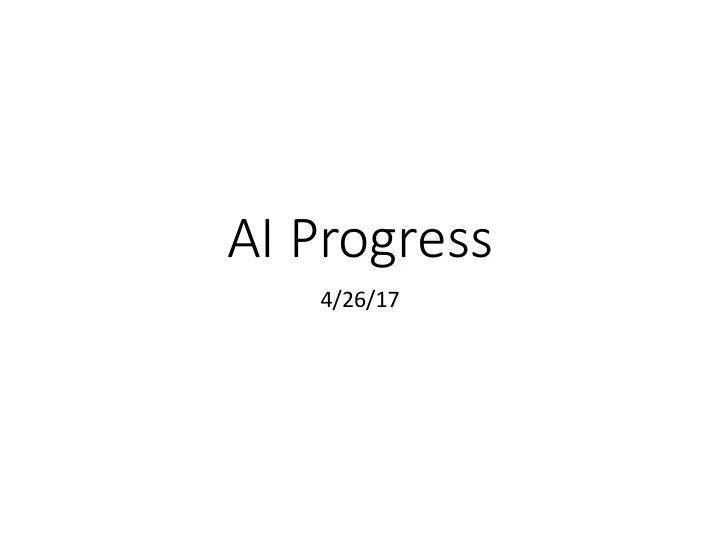

AI Progress 4/26/17
How close are we to achieving AI? We’ve come a long way. The techniques for search and machine learning that you’ve learned this semester have played a big part in major AI milestones: AlphaGo Watson autonomous cars
Robots are great at some tasks. https://www.youtube.com/watch?v=6KRjuuEVEZs
Robots aren’t general purpose. https://www.youtube.com/watch?v=8P9geWwi9e0 https://www.youtube.com/watch?v=NeFkrwagYfc
Watson’s Blunder https://www.youtube.com/watch?v=Y2wQQ-xSE4s
Watson’s blunder: what happened? • Watson relies on data scraped from the web, along with natural language processing and machine learning algorithms. • Watson used an ensemble of “experts”, but each expert is a machine learning algorithm that tries to model data by fitting some simple function. • Our common sense knowledge would immediately limit consideration to cities in the US, but Watson’s statistical models aren’t explicitly reasoning about geographical boundaries.
The Loebner Prize An annual competition based on the Turing test. • Chatbots and humans interact with human judges by a text interface. • Bots compete to fool as many human judges as possible. • Some bots have achieved the 30% threshold to “pass” the test. • These bots are actually terrible; it’s easy to distinguish them if you try. • They rely on deception and diversion: changing the subject, throwing in misspellings and human-like ticks, and refusing to answer questions. • Human entrants have had more success passing for bots than vice versa.
Computer Vision
What can/can’t we do in CV? We can (unreliably): • Classify handwritten digits. • Identify faces. • Track objects moving through a scene. • Identify cat videos. We can’t: • Accurately identify 3d positions and actions in a 2d image. • Apply external knowledge to interpret a scene.
So, what have we learned and what is it good for? We’ve learned many search techniques: • heuristic search, local search, game tree search, Monte Carlo search, value iteration, Q-learning + Search works in simple, well-regulated domains. • Games like chess and go. • A carefully laid-out warehouse − But search clearly isn’t enough. • If PacMan gives you problems, you’re pretty far from general AI. • Search requires an abstract model; operating in the real world is much harder.
So, what have we learned and what is it good for? We’ve learned techniques for machine learning : • classification, regression, reinforcement learning, clustering, dimensionality reduction, neural networks, ensemble methods + ML is good at inferring simple functions. + ML works well when we have lots of data. − Without training data, there’s not much ML can do. − It’s hard to learn complex functions with many inputs and outputs; we need tons of data, and risk overfitting.
Remember, AI changes rapidly “We see this in the fads and fashions of AI research over the years: first, automated theorem proving is going to solve it all; then, the methods appear too weak, and we favour expert systems; then the programs are not situated enough, and we move to behaviour-based robotics; then we come to believe that learning from big data is the answer; and on it goes. I think there is a lot to be gained by recognizing more fully what our own research does not address, and being willing to admit that other AI approaches may be needed for dealing with it.” -Hector Levesque (2013)
Recommend
More recommend